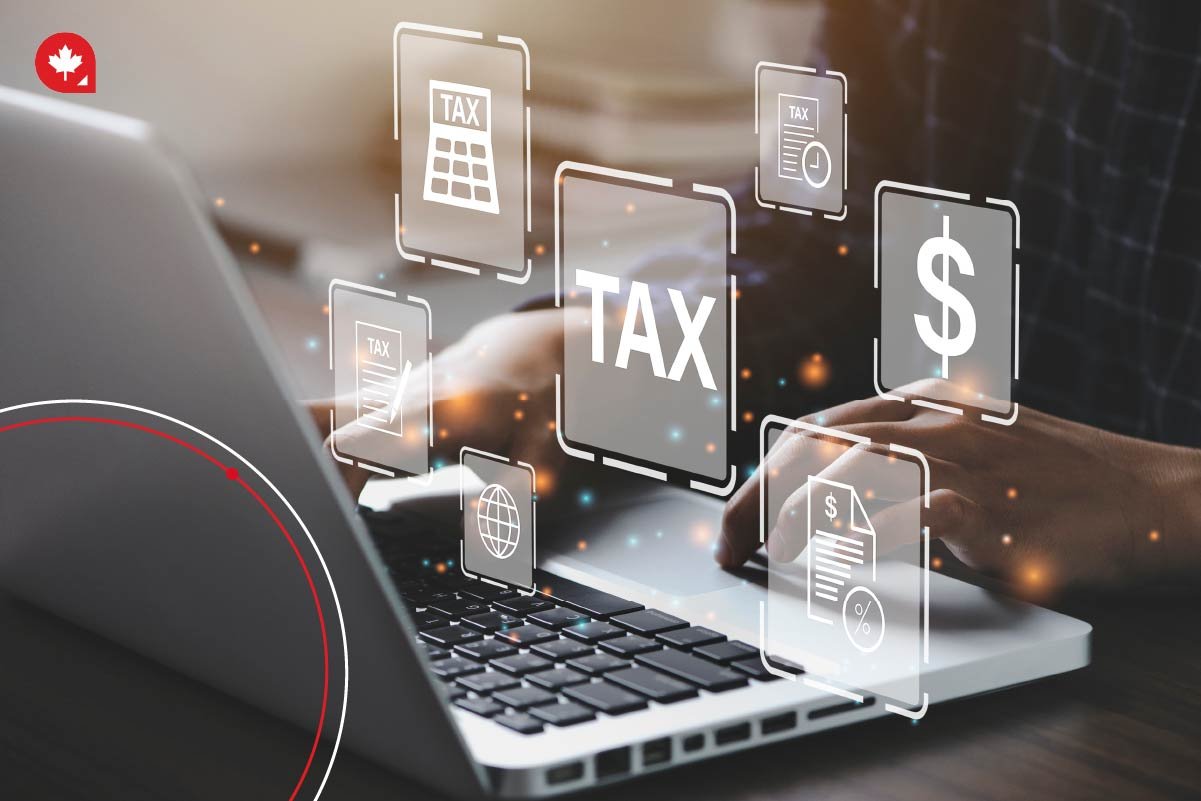One of the essential things to settle in your first year in Canada is filing your Canadian taxes. Understanding how to file taxes in Canada is not just a legal requirement but a crucial step toward financial responsibility and compliance. We've put together a guide to understanding tax percentages, residency requirements, filing options, and how to get the most out of your return.
The Canadian Tax System

Canada's tax system, like many others, works through a combination of withholding and installments. For most people, employers or other payers automatically deduct taxes from your income throughout the year. This makes tax time less stressful. If you run a business or have rental income, you'll typically pay taxes by installment to avoid a large year-end bill.
Taxes are crucial for funding the programs Canadians rely on. Tax contributions make everything from well-maintained roads to quality healthcare and social security benefits possible.
Filing your tax return is an annual process. You'll use an Income Tax and Benefit Return form to report your income, claim deductions, and calculate how much tax you owe (or how much of a refund you're entitled to). This form goes to the Canada Revenue Agency (CRA).
Who Must File a Tax Return in Canada
You will have to file tax in Canada, even if you've only lived here for part of the year. You will be required to file for the current tax year's Income Tax and Benefit Return if:
- You must pay tax for this tax period
- You wish to get a tax refund
- You want to get a tax benefit and credit payments
Note that if you don't earn a high salary and need help with filing tax returns, you could qualify for free tax assistance from the Community Volunteer Income Tax Program (CVITP) or Income Tax Assistance – Volunteer Program (for residents of Quebec).
Newcomers who are self-employed can get assistance with understanding tax obligations from the CRA's Liaison Officer Service.
Becoming a Resident of Canada for Income Tax Purposes
Before you get started with taxes in Canada, it's important to know when you're considered a resident for tax purposes. You become a resident when you have strong ties to Canada, like when you:
- Own a home here
- Have family move in with you here
- Have personal items such as a car or furniture here
- Have a Canadian driver's license
- Have a Canadian bank account
- Have Canadian health insurance
The list of newcomers to Canada who could have these ties includes:
- Refugees
- People with Canadian permanent residency
- People who have moved but have approval to stay in Canada
Checking Your Residency Status
Not sure about your residency status in Canada? Then, fill out Form NR74, Determining an Individual's Residence Status. Form and send it to the CRA for assistance before your tax return due date. For more details, you can check the Income Tax Folio S5-F1-C1.
Getting Your Canadian Social Insurance Number (SIN)

As a newcomer to Canada, you'll encounter a term called a Canadian Social Insurance Number (SIN). A SIN is a unique nine-digit number that serves as your identification for tax and benefit purposes in Canada. It's confidential and should be kept secure.
Why is a SIN Important?
The Canada Revenue Agency uses your SIN to track your income tax and benefit information. You'll also need to provide your SIN to anyone who prepares tax slips for you, such as a T4 slip (employment income summary).
If you're transitioning to Canadian permanent residency and currently use one of the following, you'll need to apply for a new SIN with Service Canada:
- Temporary SIN (starts with a "9")
- Temporary Tax Number (TTN) from the CRA
- Individual Tax Number (ITN) from the CRA
Once you receive your new permanent SIN, don't use any previous SINs, TTNs, or ITNs that were assigned to you.
Applying for a SIN
There are three ways to apply for a SIN:
- Online - Apply online for a SIN and upload your digital documents securely.
- In Person - Visit your nearest Service Canada office to apply in person.
- By Mail - You can also submit a mailed application.
Finding Your Tax Package
In Canada, a tax package is a collection of documents produced by the CRA to help you file your income tax return. It's essentially an information kit specific to your province or territory of residence on December 31 of the tax year.
Your Tax Package
Here's a breakdown of what a tax package typically includes:
- Federal Tax Information - This section provides an overview of federal tax rules, deductions, and credits that apply to all Canadians.
- Provincial or Territorial Information - This section details the specific tax rates, deductions, and credits that apply in your province or territory. It's important to use the correct package, as these details can vary significantly across provinces.
- Income Tax Return Forms - These are the official forms you need to complete and submit to the CRA to file your return. The package will include a general Income Tax and Benefit Return (T1) form and may also include additional provincial or territorial schedules depending on your situation.
- Guides and Instructions - The package typically includes booklets or pamphlets that explain how to fill out the tax return forms and claim the deductions and credits you're eligible for.
Why Using the Right Tax Package Matters
Filing your Canadian taxes can seem complex, especially with all the different provinces and territories. However, one key element that can significantly impact your return is using the right tax package. Here's why it matters:
- Tax Rates - Each province and territory has its own tax rates on top of the federal tax rates. Using the wrong package could lead you to miscalculate your total tax liability.
- Deductions and Credits - The availability and value of tax deductions and credits can differ between provinces and territories. Using the appropriate package ensures you claim all the benefits you're entitled to in your area.
Tax Filing Options
Once you've gathered your documents and crunched the numbers, it's time to submit your Canadian tax return. The good news is you have options. Whether you prefer an online approach or a traditional method, here's a breakdown of the different ways to file your return in Canada.
Filing Electronically
Filing your taxes electronically is convenient. You have two options here:
- NETFILE - This is the CRA's secure online service that allows you to file your return electronically using certified tax software or a web tax application. NETFILE provides a list of approved software options, some of which are even free.
- EFILE - This CRA service lets authorized service providers, such as discount tax preparation companies, file your return electronically on your behalf.
Paper Tax Return
If you prefer a traditional method, you can complete a paper tax return and mail it to the address specified by the CRA. Double-check the mailing instructions to ensure your return gets delivered to the correct location.
Tax Return Due Dates
Filing your taxes on time is important to avoid any penalties or delays in receiving your refund. Here's a quick guide to the key due dates for your 2023 tax return, depending on your situation:
- Most Taxpayers in Canada - For the vast majority of taxpayers, the deadline to file your return and make any required payments falls on April 30, 2024.
- Self-Employed with Tax Shelter Investments - If you're self-employed and your spouse/common-law partner has business expenditures primarily related to a tax shelter investment, you also have an April 30 deadline for both filing and payment.
- Self-Employed (General) - For all other self-employed individuals and their spouses/common-law partners, the deadline to file your return is extended to June 15, 2024. However, any taxes owing are still due by April 30, 2024.
File on Time and Be Accurate
The CRA takes tax obligations seriously, and there can be consequences for late filing or inaccurate returns. Here's what you need to know.
Late Filing Penalties
If you file your return late and owe taxes for 2023, you may be charged a penalty. This penalty can be particularly steep if you've also neglected to report income on your tax returns for the previous three years (2020, 2021, or 2022).
Intentionally providing false information or omitting key details on your return can also result in penalties.
Interest
If you have a balance owing for 2023, interest starts accruing daily on any unpaid amount from May 1, 2024. This applies even if the CRA reassesses your return after you file it.
In some cases, the CRA will pay you interest on your tax refund for 2023. This interest starts accumulating on the latest of three dates: May 30, 2024, the 30th day after you file your return, or the day you overpaid your taxes.
Tax Benefits and Credit Payments

In Canada, individuals and families can receive benefits and credit payments to help with the cost of living and raising a family. Depending on your income and family situation, you can receive these payments even if you have just arrived in Canada.
Once you've filed your first Canadian income tax and benefit return or applied for the Canada child benefit or goods and services tax/harmonized sales tax (GST/HST) credit, you will need to file your tax return every year to continue to receive the benefit and credit payments you may be entitled to.
Available Benefit and Credits
Many Canadians receive benefits and credit payments, and you could too. Here's a brief explanation of each.
| Benefit/Credit | Description |
|---|---|
| GST/HST credit | Every three months, eligible individuals may get money to help offset what they pay in goods and services tax/harmonized sales tax |
| Canada Carbon Rebate | Every three months, eligible individuals residing in an applicable province or territory on the first day of the payment month may get money back to offset the cost of the federal pollution pricing |
| Canada child benefit | Every month, eligible individuals may get money to help with the cost of raising a child |
FAQs
What Happens After I File a Tax Return in Canada?
Once the CRA processes your return, you'll receive your first Notice of Assessment (NOA) in the mail. This important document clearly outlines whether you'll be receiving a tax refund or if you owe any taxes for the year. This document is crucial, so be sure to store it in a safe place for your records.
Can Moving Expenses be Deducted When I File Taxes in Canada?
You usually wouldn't be allowed to deduct moving expenses when you immigrate to Canada. There is, however, an exception if you have moved to Canada as a full-time student enrolled in a post-secondary program at a university, college, or other educational institution. When doing this, you must have received a taxable Canadian scholarship, bursary, fellowship, or research grant from that educational institution. If this applies to you, you could qualify for a deduction from moving expenses.




